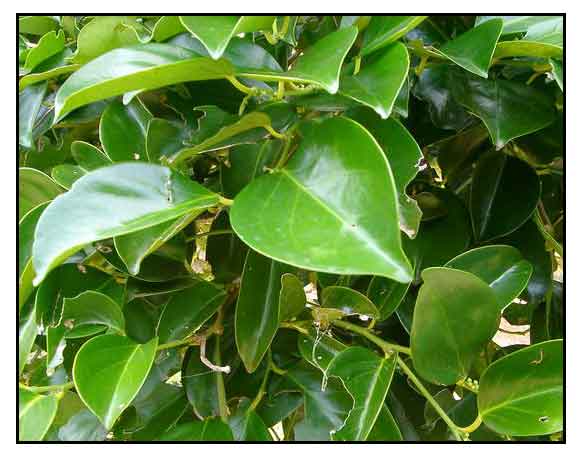 Botany Botany
Taiñgang-babui is a small, erect tree with long, slender branches. Leaves are few, alternate, leathery, smooth, shining, paler beneath, broadly ovate or subelliptic, 18 centimeters long or less, about 9 centimeters wide, rounded at both ends or broadly obtuse at the base. Inflorescence is axillary, cymosely short-branched, scarcely longer than the petioles. Flowers are pale white, with small calyx and columnar, and are borne on inflorescences at the axil of the leaves. Fruit is nutlike, smooth, purplish-black, ellipsoid, 3 to 4 centimeters long, with a black fibrous husk surrounding a fairly hard, white kernel.
Distribution
- Common in primary forests at low and medium altitudes, ascending to 750 meters, in the Batan Islands and all the provinces in Luzon.
- Also reported in Taiwan, Borneo, Indonesia, Celebes and Moluccas.
Constituents
- Study of leaves, branch, stem and root bark yielded a new secoiridoid glycoside, gonocaryoside E.
- Study of leaves of Gonocaryum calleryanum yielded four new secoiridoid glycosides and a new flavonoid glycoside, apigenin 7-O-β-apiofuranosyl (1 → 6)-β-d-glucopyranoside, along with six known flavonoids and flavonoid glycosides, apigenin, apigenin-5,7-dimethyl ether, apigenin trimethyl ether, apigenin 7-O-glucoside, apigenin 7-O-neohesperidoside, and vitexin. (4)
- Study of seeds yielded three new secoiridoid constituents, goncarin A-C (1-3), a new derivative goncarin A monoacetate (4), along with two known lignins, pinoresinol (5), and paulownin (6). (see study below) (6)
- Study of leaves, branch, stem and root bark yielded a new secoiridoid glycoside, gonocaryoside E, together with 14 known compounds. (8)
Properties
- Considered stomachic.
- Study has suggest anti-inflammatory property.
Uses
Folkloric
- Plant used as a cure for stomach troubles.
- In Lipa City, A tree identified as Anilao with a scientific name of Gonocaryanum caleryanum, used in Batangas to treat malaria and rheumatism. (9)
- In Nueva Ecija, decoction of chopped bark drunk for snake bites. (10)
Others
- Lumber: Wood used for indoor construction.
- Vet: Hunting dogs subjected to the smoke of burning flowers or fruits said to be very good at catching wild hogs or deer. (7)
Studies
• Secoiridoid Glycosides: Study of leaves, branch, stem and root bark of Gonocaryum calleryanum isolated a new secoiridoid glycoside, gonocaryoside E, together with 14 known compounds. (1)
• Secoiridoid and Flavonoid Glycosides: Study of leaves of Gonocaryum calleryanum yielded four new secoiridoid glycosides and a new flavonoid glycoside, apigenin 7-O-β-apiofuranosyl (1 → 6)-β-d-glucopyranoside, along with six known flavonoids and flavonoid glycosides, apigenin, apigenin-5,7-dimethyl ether, apigenin trimethyl ether, apigenin 7-O-glucoside, apigenin 7-O-neohesperidoside, and vitexin. (4)s
• Secoiridoids / Anti-Inflammatory / Inhibition of LPS-induced Tumor Necrosis Factor and NO Production / Seed: Study of seeds yielded three new secoiridoid constituents (1-3), a new derivative goncarin A monoacetate (4), along with two known lignins (5-6). Study evaluated the the anti-inflammatory effects of compounds 1-6 on lipopolysacchardie (LPS) stimulated murine macrophage cell lines (RAW 264.7). The compounds significantly inhibited the production of NO (40-80%, p<0.01-0.05) via suppression of inducible NO synthase. There was also significant reduction of LPS-stimulated tumor necrosis factor. Results suggest compounds 1-3 have potential for treatment of inflammatory diseases associated with macrophage activation. (see constituents above) (6)
Availability
Wild-crafted.
|

![]()



 Botany
Botany